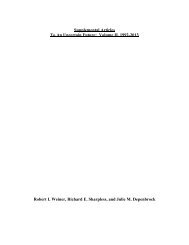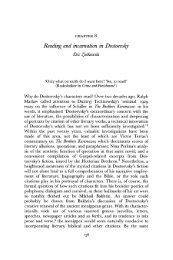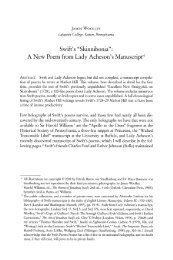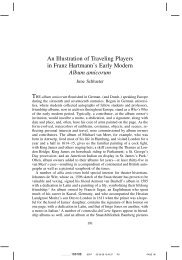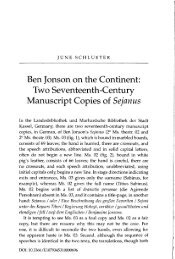courses of instruction - Lafayette College
courses of instruction - Lafayette College
courses of instruction - Lafayette College
You also want an ePaper? Increase the reach of your titles
YUMPU automatically turns print PDFs into web optimized ePapers that Google loves.
INTERIM SESSION<br />
Redistribution <strong>of</strong> carbonate material by wind<br />
and water, and the geomorphic processes that<br />
operate to further shape carbonate platforms,<br />
including groundwater flow, cave develop<br />
ment, and the unique hydrolic interaction be<br />
tween the oceans, groundwater, and inland<br />
lakes and ponds are considered. Field studies<br />
based on San Salvador and North Andros Is<br />
lands. Mr, Germanoski, Ms. Schubel<br />
Geology 150. Geologic Evolution <strong>of</strong> the Ha<br />
waiian Islands. The Hawaiian Islands, which<br />
range from 25 million years to minutes in age,<br />
provide a unique opportunity to study both<br />
the active volcanic processes that have built<br />
the islands and the geomorphic processes<br />
that have altered the volcanic landscape. By<br />
examining active lava flows, volcanic terrains,<br />
rain forests, deserts, and beaches, we will at<br />
tempt to understand the volcanic processes,<br />
surface and groundwater flow, glaciers, and<br />
coastal processes that reshape the landscape.<br />
Meets lab science requirement.<br />
Mr. Malinconico, Mr. Germanoski<br />
ART<br />
191. Promotion Design: The Creative<br />
Potential <strong>of</strong> Production Techniques. This<br />
course looks at promotion design as not sim<br />
ply decoration <strong>of</strong> verbal content, but as the<br />
visual communication <strong>of</strong> that content. It ex<br />
plores the three main aspects <strong>of</strong> the produc<br />
tion process typography, paper, and spe<br />
cial production techniques with regard to<br />
their inherent creative and communicative<br />
properties as well as their efficient use in<br />
effective visual communication. Mr. Minter<br />
193. Techniques with Watercolor. An<br />
introduction to the elements <strong>of</strong> line, value,<br />
color, and composition as they relate to water-<br />
color. All aspects <strong>of</strong> watercolor are covered in<br />
a step-by-step program. Types <strong>of</strong> techniques<br />
range from dry brush to the various wet-on-<br />
wet styles. The types <strong>of</strong> paper available to the<br />
medium are explored as well. Staff<br />
196. Basic Photography (Black and White).<br />
This course introduces students to the tech<br />
niques <strong>of</strong> film exposure, developing, contact<br />
printing, and pro<strong>of</strong>ing. In addition, the<br />
course exposes students to the aesthetics <strong>of</strong><br />
176<br />
black and white photography, presentation <strong>of</strong><br />
work, and a brief history <strong>of</strong> the subject. Stu<br />
dents should have their own cameras. Limit<br />
ed to 12 students. Mr. Mason<br />
219. Visual Expression and "Controlling"<br />
the Painted Surface. This course focusses<br />
on manipulating the painted surface in ab<br />
stract painting. Students experiment with<br />
methods <strong>of</strong> applying paint and work toward<br />
developing their own expressive techniques.<br />
The course requires the completion <strong>of</strong> three<br />
sequenced projects, participation in project<br />
critiques, and museum and studio visits.<br />
Mr. Tiernan, Mr. Toia<br />
290. Graphic Design: Solving Communi<br />
cation Problems. Communicating through<br />
design is as complex as the amount <strong>of</strong> infor<br />
mation being disseminated in today's envi<br />
ronment <strong>of</strong> rapid communication. This is<br />
an intermediate studio course which ex<br />
plores in-depth the technologies, visual lan<br />
guage, and studio skills necessary to create<br />
effective marketing communication. Pre<br />
requisite: Art 191. Mr. Minter<br />
BIOLOGY<br />
304. Tissue Culture and Virology. An<br />
introduction to the theories, principles,<br />
and evaluations <strong>of</strong> the latest techniques<br />
employed in tissue culture and virology.<br />
Laboratory work stresses experimental pro<br />
cedures and designs used in the culturing,<br />
handling, and study <strong>of</strong> animal cells. Addi<br />
tionally, students carry out one or more in<br />
dependent research projects. Prerequisites:<br />
Biology 101-102, and permission <strong>of</strong> instruc<br />
tor. Mr. Majumdar<br />
390. Botanical Measurements. Employing<br />
techniques commonly used with botanical<br />
materials, this course surveys the algae,<br />
lichens, and bryophytes in the areas <strong>of</strong><br />
anatomy, morphology, physiology, and<br />
ecology. Laboratory includes field collec<br />
tions, specimen identification, practice in<br />
aseptic techniques, physiological measure<br />
ments, and assessment <strong>of</strong> morphogenic<br />
changes. Prerequisites: Biology 101-102,<br />
and permission <strong>of</strong> instructor. Limited to<br />
12 students. Ms. Mineo



